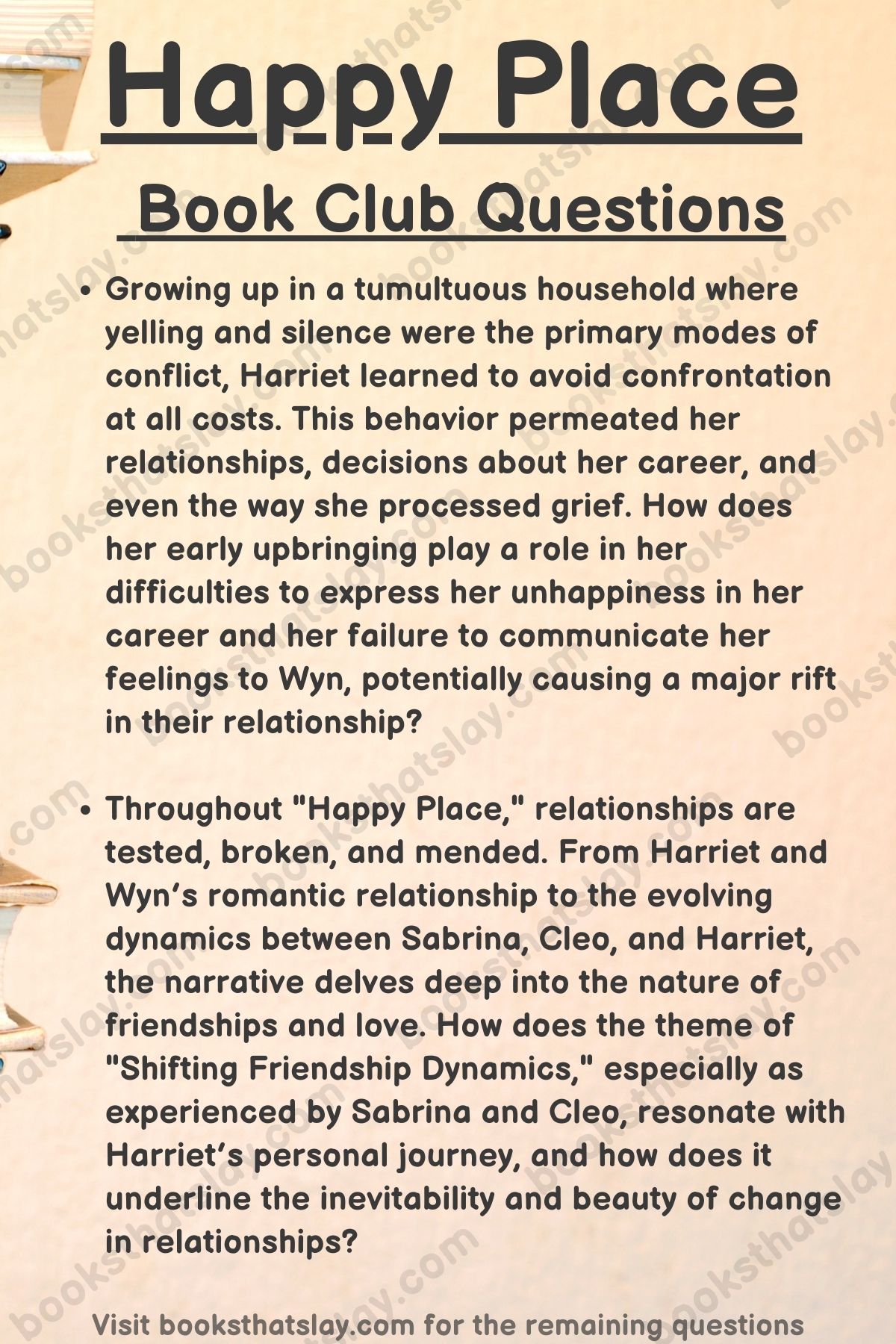10 Happy Place Book Club Questions for Discussion
Every so often, a novel comes along that feels like a reflection of our own lives, echoing the secrets of our hearts, the trials of our relationships, and the quest to find our true passion. Emily Henry’s “Happy Place” is one such book that, from its evocative setting in a cozy Maine cottage to its intricate web of relationships, promises to tug at your heartstrings.
Whether you’re a seasoned romance novel aficionado or someone seeking solace in a tale of rediscovery, this book speaks volumes.
Dive in with me as we explore some amazing book club questions for Happy Place where the evolution of long-standing friendships and the courage it takes to truly follow one’s heart is what makes lives worth living.

Happy Place Book Club Questions
- Throughout the novel, readers witness Harriet’s internal struggle as she grapples with the weight of her surgical residency—a career she chose to please her parents and one that she doesn’t truly love. This narrative arc draws attention to the larger societal pressures people face, especially from family expectations and the fear of disappointing loved ones.
How does Harriet’s decision to abandon surgery and embrace pottery highlight the significance of personal happiness and fulfillment over societal pressures and familial expectations? - Growing up in a tumultuous household where yelling and silence were the primary modes of conflict, Harriet learned to avoid confrontation at all costs. This behavior permeated her relationships, decisions about her career, and even the way she processed grief.
How does her early upbringing play a role in her difficulties to express her unhappiness in her career and her failure to communicate her feelings to Wyn, potentially causing a major rift in their relationship? - The friendship dynamics between Harriet, Sabrina, and Cleo provide a deep exploration into the changing nature of relationships over time. As college friends transition to adulthood, their priorities shift and distances grow, leading to feelings of resentment, misunderstanding, and longing for past connections.
In what ways does the novel emphasize the necessity of open communication, understanding, and adaptation in maintaining long-term friendships, especially in light of the confrontations that occur between the friends at the cottage? - Throughout his life, Wyn has felt overshadowed by his more academically-inclined sisters, leading to a diminished sense of self-worth. This is further compounded when he enters into a relationship with Harriet, a bright and driven woman, making him feel even more inadequate.
In what ways does Harriet’s journey of self-discovery and openness help Wyn to recognize and value his own strengths, eventually finding contentment and success in his carpentry business? - Wyn’s move back to Montana after the death of his father and his mother’s Parkinson’s diagnosis paints a poignant picture of grief, familial obligations, and depression. These events greatly impact his relationship with Harriet and contribute to their eventual breakup, revealing the complexities of navigating personal trauma within romantic relationships.
Considering Wyn’s emotional journey, to what extent does the novel explore the challenges and responsibilities of supporting a partner through grief, and where should one draw the line between personal well-being and the well-being of the relationship? - Sabrina’s character is a tapestry of fear, from fearing the loss of her beloved family home to the potential distance growing between her closest friends. Her efforts to control and maintain the status quo reflect her deeper anxieties about change.
How does her eventual acceptance of change and her vulnerability in the chapel scene act as a catalyst for both her own personal growth and the deepening bonds of her friendships? - A central plot point revolves around Harriet and Wyn pretending to be in love and maintaining the facade of their engagement for the sake of their friends. This act of deception adds tension to their interactions and forces them to confront unresolved feelings and misunderstandings from their breakup.
How does their decision to hide the truth underscore the theme of the lengths people will go to avoid conflict, and what does their eventual confession reveal about the importance of authenticity in relationships? - Cleo serves as a foil to Harriet’s conflict-averse nature, showing strength in her ability to set clear boundaries, even when faced with strong-willed individuals like Sabrina. Yet, like many characters in the story, she grapples with self-doubt, particularly surrounding her impending motherhood.
How does Cleo’s character challenge and inspire Harriet to be more assertive, and how does her personal journey to self-acceptance shape the dynamics within their friend group? - Throughout “Happy Place,” relationships are tested, broken, and mended. From Harriet and Wyn’s romantic relationship to the evolving dynamics between Sabrina, Cleo, and Harriet, the narrative delves deep into the nature of friendships and love.
How does the theme of “Shifting Friendship Dynamics,” especially as experienced by Sabrina and Cleo, resonate with Harriet’s personal journey, and how does it underline the inevitability and beauty of change in relationships? - The annual gathering at the Maine cottage serves as a backdrop for many of the book’s pivotal moments, symbolizing both a sanctuary from the world and a crucible where emotions and conflicts come to a head. The setting’s nostalgic and sentimental value contrasts with the raw emotions and confrontations that transpire within its walls.
Given the novel’s emphasis on places of refuge and memory, in what ways does the Maine cottage represent both the idealization of the past and the stark realities of the present, and how does it contribute to the characters’ personal growth and revelations?
Check out our discussion questions for other books –